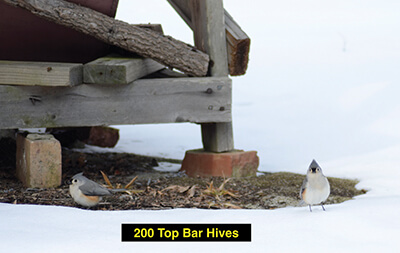
As spring appears, here are three events to observe, ranging from the rarely seen to perhaps the under reported.
In a melting March snow, the air too cold for bee flight, I was out patrolling my rural apiaries and came upon some birds fluttering around the hive stands. With the tracks in the snow cover, I could tell what had been going on through the apiary (see Figure 1). The snow cover made foraging difficult for the birds that feed on seeds, like the ones typically seen at backyard bird feeders. The snow began melting away quicker by the warmth radiating from the hive stands (see Figure 2).
Strangely even in the cold, a trickle of bees flew out from one of the hives (roughly estimated as a bee every few minutes). The bees quickly became disoriented in the bright sunlight over the blinding white snow. The bees fell (or flew) into the snow pack in the apiary and buzzed on the ice until quickly becoming chilled by the cold.
For many years, bee scientists and beekeepers have observed this odd bee behavior, bees leaving the hive during bright sunny days with snow on the ground. I do not think the cause(s) have been experimentally determined. Usually the bees accumulate in the snow in front of the hive. For me that day, the curious bee behavior set up the following bird behavior.
I let the bee truck roll quietly, engine off, beside the apiary, using it like a bird blind. After waiting for a while in the cold, the Tufted Titmice returned to the hive stand. Eventually a bird flew over in front of the hive leaking bees and caught a bee chilling in the snow. The Tufted Titmouse pecked at the chilled bee several times, shown by the telephoto lens (see Figure 3). The Tufted Titmouse then took the bee up on a large tree branch. I heard pecking against sturdy wood. Presumably the bird pecked out the bee’s flight muscles. That protein would be quite nutritious compared to the rest of the bee. This behavior is similar to the bird finding a large seed on the ground and taking it up on a tree branch to peck out its contents.
What I thought was surprising, revealed by the photograph taken at the exact moment of lift-off, was how the bird held the bee for carrying–by the tip end of her abdomen–See Figure 4. The timing on the photograph was nearly perfect. I took this picture about four years ago and have not had a similar situation to take another.
When the weather warms, the snows melt away, and small pits might appear in the ground (See Figure 5). The pits are not restricted to apiaries. They can occur most anywhere. What made the pits? Nocturnal skunks digging for grubs (see Figure 6). As skunks become more active in the spring, death by car collision becomes more frequent too, as does the odor, another a sign of spring. My game cameras have caught skunks irritated by something–with their tails up (see Figure 7). So far, no spraying has occurred in my apiaries.
Skunks venture into apiaries beginning in the spring and may continue into the summer. With traditional frame hives, low to the ground, a skunk scratches at the hive entrance and “eats” the defending bees. The skunk spits out a ball of these chewed-up bee parts, that is, the broken up exoskeletons (see Figure 8). Presumably, the skunk sucked away any honey in the bees. I wonder if the skunk’s saliva might have also digested out the bees’ flight muscles, or other sources of nutrition from the dead bees.
Keeping bees in different hive designs gives a beekeeper different apicultural perspectives. As shown above with the birds, my top-bar hives are up on 30-inch (76.2 cm) tall hive stands. My recently-begun frame hives are up ….


